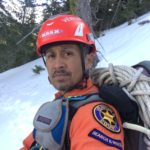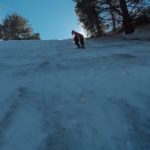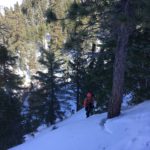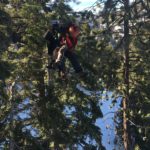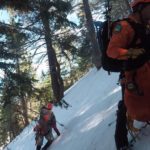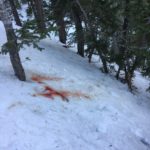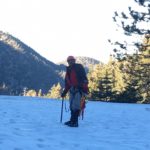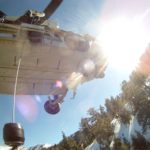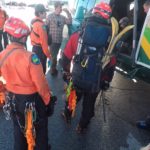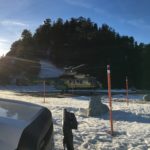Islip Saddle Rescue 02/04/17
We gathered for our monthly training with the goal of practicing our Ice and Snow rescue techniques and self arrests. We had travelled out of county, into Los Angeles County , northbound on the Angeles Crest Highway, approximately 40 miles northeast of La Cañada. We found an area of snow and ice pack that allowed us to break up into groups, within visual of each other, each group practicing a skill set. I was with 3 other teammates in a simulated avalanche situation. We were practicing locating a buried avalanche beacon, using our personal beacons to triangulate over the subject, then using avalanche probes and shovels to dig them out. We had also dug snow trenches to analyze the way the layering of the snow and ice had influenced the conditions over the last few weeks.
Suddenly we were being recalled back to the Rescue Trucks over the PA. Apparently we there was some situation that had just locally occurred. Mobilizing our equipment and being briefed on the situation, we were silent--Our usual light demeanor on hold, no joking or laughing--mentally preparing for the coming uncertain task.
We had already sent a first “Hasty Team” consisting of two of our highest medically trained members (one a medical doctor and the other an experienced EMT) to get an initial assessment and call out what resources would be needed in the field. FIve hikers had been reported to have fallen down an icy slope about 1.25 miles from the trailhead. All were missing and had to be found. The conditions being very steep (up to 70 degree slope) with trees and rocks, we knew that anyone falling down this environment would be colliding with these obstacles at high speed, probably multiple times.
I was part of the second Hasty Team that was at the fall site. We had audibly heard one male hiker who had fallen about 75 feet below the trail. One of my team mates and I were assigned to safely access him, medically assess and stabilize him. Once we reached him, we realized he was in pretty bad shape. What had stopped him from falling further was a stout tree that he was slightly wrapped and lodged around. The left side of his face was badly contused, with an obvious fracture to his left forearm. He was also complaining of pain in his left ribs and back, and was obviously beginning to suffer from hypothermia and shock. One of the other members of the team had already supplied him a splint, which I set and secured to his forearm and wrist We tried as best we could to cover him with our jackets to reduce his body heat loss. Since we had a helicopter standing by, we made the decision to airlift him out. As the chopper neared, I secured him with a harness around his body, to which I attached a Belay Line (as well as myself) so that we would not fall any further. I moved him away from the tree and painfully made our way another 20 feet down the slope into a clearing so that the helicopter could better access us. The chopper neared and verbal communication was almost impossible due to the rotor wash. What we did not know, is that another hiker had been located and was unfortunately in worse condition with a possible spine injury. Once we had gotten him out, another chopper came in to pick up our second subject.
Our third subject was not injured and assisted in identifying what had happened (originally we did not know he was one of the 5 missing hikers). Our third subject was found wrapped around a couple of trees, unconscious and unresponsive, he eventually had succumbed to his injuries and died at the scene. Our fifth and last subject had sustained some minor injuries, complaining of tightness in her chest and some knee pain--we decided to airlift her out as well.
There was some confusion as we had not identified our third subject as one of the hikers so until we had confirmed all were accounted for, we continued searching. Fortunately, we only had this misinformation for about half an hour.
Upon the cancellation of the search, I made my way down to our deceased subject and assisted in documenting the scene as we waited for the Coroner. Then we packaged the body into a litter and had to safely lower him down to the road, almost 300 feet below.
This incident was a very complex rescue which consisted of many issues that we train for. Usually when we have been called out of county to assist on a snow incident, we might be called upon for one specific task, but this was a Mass Casualty Incident (MCI) that took place in a very dynamic, changing environment with lots of variables. I was grateful that we were prepared, capable and did our jobs as a team--keeping each other safe and performing well under the circumstances.
NBC News story link: http://www.nbclosangeles.com/news/local/Training-Exercise-Becomes-Real-Life-Rescue-417838983.html
Ventura County Star Newspaper link: http://www.vcstar.com/story/news/local/2017/02/05/county-rescue-volunteers-lead-ice-chute-rescue/97522896/
GoPro Video from teammate’s helmet camera
Click to view full video: https://drive.google.com/open?id=0ByF6Eo_LftBodno3akJJLXZyZ1k
